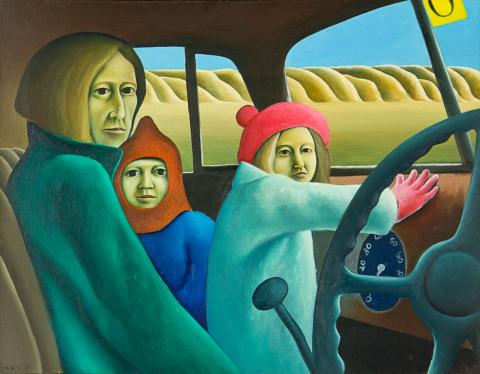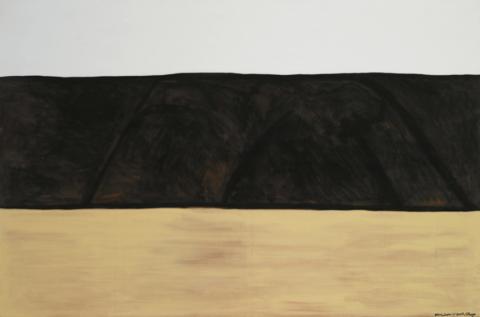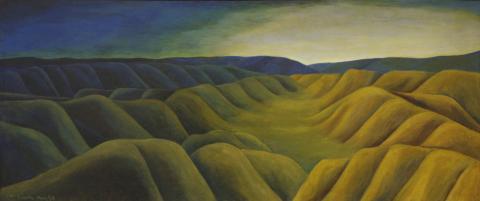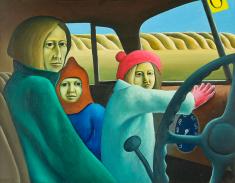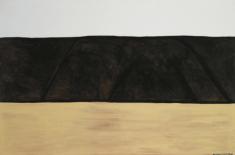Michael Smither
Family in the Van, 1971
Where are they? Which part of New Zealand stands in for the holy land in this family portrait, with Michael Smither’s wife Elizabeth showing the weariness of family road trips and the faces of the two children still enlivened by the adventure? The landscape suggests Otago; and by the pale sun on their faces and the hills behind them, they have been driving towards the light. Perhaps they are going northeast through the Ida valley; or further south, travelling inland towards Middlemarch past the Rock and Pillar Ranges. Whichever it is, the landscape also pays homage to Colin McCahon’s North Otago paintings.
Just four years before Smither’s painting, in October 1967, McCahon exhibited 25 North Otago landscape paintings at Barry Lett Galleries in Auckland. The exhibition revealed McCahon’s flattening of landscape into three simple, almost abstract horizontal bands: a pale cloudless sky; a flat band of hills in the middle distance with simple diagonal contour lines for ridges; and a flat and featureless foreground plain. Smither’s painting replicates the abstract bands out the windows of the van, almost like a theatrical backdrop; but with greater tonal modulation in the hills, more like those in McCahon’s earlier “Takaka: night and day” (1948).
“Family in the Van” comes at a time when Smither was painting simple domestic scenes drawn from his daily life, yet with a religious undercurrent in order to make them more substantial. This painting becomes a contemporary portrait of the holy family’s flight into Egypt. The artist places himself in the picture by looking on from the driver’s seat; but he is not driving at the time: the speedometer is at zero. The painting suggests a moment of reflective pause in the journey; one where the family takes stock of each other and their place: together and wrapped up against the cold. For the Catholic Smither, coming shortly after the time of the liberal Second Vatican Council and Pope John XXIII, the painting is infused with an optimistic and “keep it real” religion. Similarly his portraits of children at this time were generous and relaxed, eschewing conventional portraiture: “We had a very restricted view of children. We used to have these photographers that went from home to home doing photographs of your children. They spent ages getting the children all flossied up and looking perfect and posing them in front of the fireplace. It was totally unlike what children are really like.”
Michael Smither, “Family in the Van” 1971, oil on canvas, 487 x 632 mm
Provenance:
Collection of Dryden Family
Collection of Mrs Janet Paul, Wellington
Collection of Les and Milly Paris, purchased from a Webb’s auction, 15 May 1986, Lot No. 42
Offered at Auction 2012:
Previously published in "The Les and Milly Paris Collection," 19 / 20 September 2012, Art+Object the 21st Century Auction House, Auckland, pp52-53.
LINKs:
The Les and Milly Paris Collection Auction Catalogue
Record prices set at auction including $234,500 realised for Smither's painting "Family in the Van"
